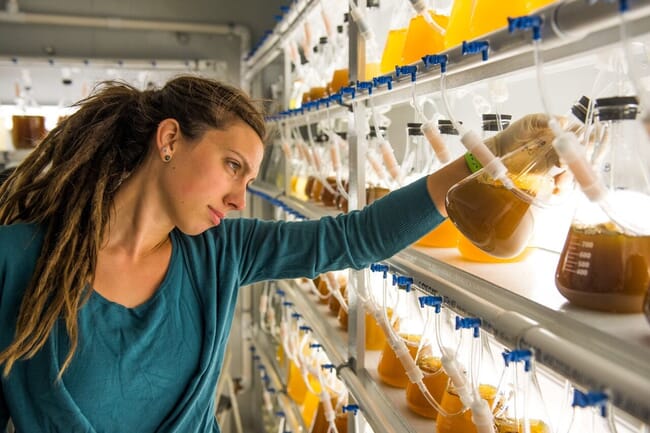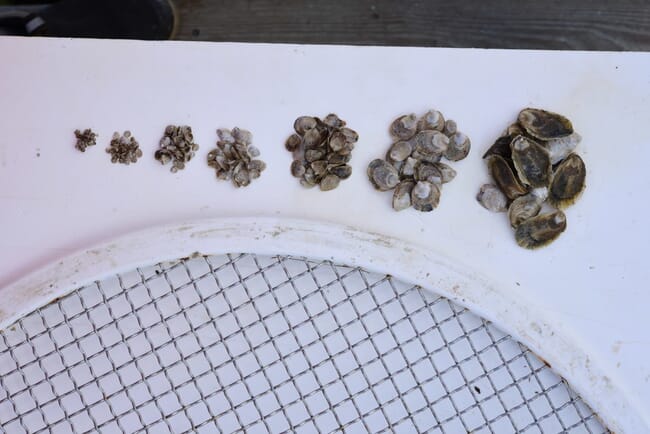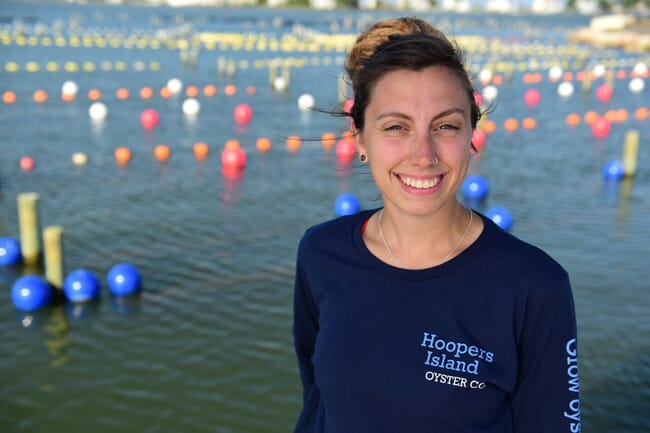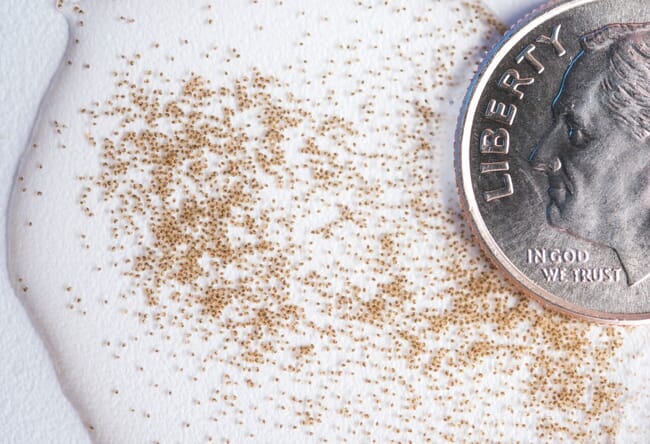Although oysters once thrived along the east coast of the United States, their numbers had declined drastically by the mid-1980s due to disease and overfishing of the public fishery. This resulted in huge financial losses for coastal economies in areas such as the Chesapeake Bay. Although there have been some signs of recovery, it is not known how many oysters exist, only that the population is much smaller than before.

In an attempt to bring back the economic and ecological value of oysters, non-profits, oyster growers and community organisations have come together under the Chesapeake Oyster Alliance, which aims to add 10 billion new oysters to the Chesapeake Bay by 2025. Nursery manager Natalie Clark works at Hoopers Island Oyster Co, one of two oyster hatcheries tasked with providing sufficient quantities of spat for the initiative. She talked to us about the value of oysters in the Chesapeake Bay and the significance of increasing sustainable oyster aquaculture in the region.
Briefly describe your aquaculture career
After graduating from Randolph-Macon College with a degree in biology and environmental studies, I started my career in aquaculture at the Hoopers Island Oyster Co as a technician for a new hatchery they launched in 2017. I quickly set out to learn everything I could about growing algae, rearing larvae and the setting process during my first growing season and was soon promoted to nursery manager.
What inspired you to start in aquaculture?
Growing up on Maryland’s Eastern Shore, I developed an early love for the Chesapeake Bay and everything related to our water-centric culture. I recall being out on boats from an early age and learning all about organisms and threats to our estuary. I have always had a love for aquatic things.
When I started college, I knew I wanted a career that would allow me to work with the creatures that inhabit the Chesapeake. Oyster aquaculture gives me that – and so much more. We’re helping to guide a new future for the Chesapeake Bay by managing excess nutrients and building a sustainable fishery. Best of all, I have the privilege of working in one of the most beautiful places on earth while making a difference environmentally and economically.
Describe a typical day in your current role
During the growing season, my main responsibility is to ensure that our oyster seed has everything it needs to thrive without limitations. My job entails everything from setting larvae and grading seed to cleaning upweller tanks and working our long-line systems. As an oyster nursery manager, there’s no such thing as a “typical” day – but no day is ever dull. I organise each day depending on which oysters need the most attention… especially since there are literally millions of them. There is one aspect of every day that is typical, however: I arrive clean, and go home dirty!

What’s the most interesting experience you’ve had working in aquaculture to date?
Attending the Chesapeake Bay Foundation’s announcement of the Chesapeake Oyster Alliance was one of the most amazing experiences in my career. Seeing the commitment and collaboration of partners in every sector – oyster farmers, government agencies, scientists and conservation organisations – to place 10 billion oysters in the bay by 2025 is incredible. It underscores how oyster aquaculture is being celebrated and elevated as a scientifically proven, naturally driven filter for clean waters and healthy ecosystems.
What are the priorities of the Chesapeake Oyster Alliance, and what do you think is key to its success?
The Chesapeake Bay Foundation’s priority has always been to “save the bay” and this initiative is just another way that it’s going about doing so. Ultimately, I believe that all those involved with the Chesapeake Oyster Alliance share the same priority as well. The oysters put back in the estuary by this project will be a huge step in the right direction in improving the overall health of the bay. To plant 10 billion oysters in seven years is certainly no small feat but the reward of doing so will be gratifying. The success of this initiative will undoubtedly come from all of those involved with the project working together across all sectors to make it happen.
What’s the most unusual experience you’ve had in aquaculture?
Working with oysters certainly has its share of unusual and astonishing experiences. This past winter, we were struck with the coldest weather we’ve had in a long time on Maryland’s Eastern Shore. Thick ice formations covered our tributaries and our oysters. Watching Mother Nature freeze everything in place for weeks was a humbling experience, and reminds me that no matter how much we want to control our situations, Mother Nature is still in charge.

How important are sustainability concerns to you and how do you address them in your work?
In Cambridge, Maryland, our way of life was built on the water. Generations of families survived and prospered by working the natural fisheries here in the Chesapeake. As these resources diminished, the sustainability of not only the fisheries but also that of the lifestyle faded away.
Aquaculture, and specifically oyster aquaculture, provides a way to restore and preserve our fisheries, our heritage and our economy. Creating a sustainable fishery through oyster aquaculture is the foundation that Hoopers Island Oyster Co was built upon. Every day we work towards maintaining a sustainable source of oyster production that can be managed throughout the Chesapeake and beyond. In addition, because we hatch our own oysters, nothing is removed from the natural stocks that remain and this allows the public demand for oysters to still be met without taking away from an already diminishing resource.
What new technical or product innovation do you think has the most potential to change aquaculture?
There are many grow-out methods in oyster aquaculture, but recent advancements in surface grow-out gear have become very sophisticated and are potential game changers. One of the best methods we’ve found to grow our seed is using a Hexcyl basket in tandem with a long-line system. This style of gear harnesses the wave action at the water’s surface to help shake and shape our oysters as they grow. The baskets are practically indestructible and can take a beating while keeping our oysters intact, which of course is the most important part.
Are there any individuals or organisations in aquaculture who you’ve found particularly inspirational?
Being part of the aquaculture community itself, both the individuals and organisations, has been very rewarding. It’s been my experience that everyone involved in oyster aquaculture is very willing to share what their experiences and insights are in order to help perfect the craft. This freely shared knowledge makes the sector uniquely inclusive – and inspirational.

Have you faced any particular challenges as a woman in aquaculture?
I’ve faced my share of challenges with aquaculture, but I’m not sure I can attribute any of them to me being a woman. For me, oyster aquaculture brings a new meaning to creative problem solving, whether you’re a man or a woman. It’s less about gender differences and more about collaborative thinking from everyone to solve the problem at hand. Everyone brings something different to the table, because everyone has different strengths, and having a good balance of those strengths leads to the best solutions.
How are women addressing inequalities in aquaculture in your region and have you seen the opportunities improve in recent years?
As aquaculture expands and grows in popularity, I think we will continue to see the ratios between men and women balance out. I went from being the only woman at Hoopers Island a year ago to now being one of four. As we grow as a company, I expect to see more strong, independent women with great ideas join our team and I certainly don’t think that that trend is unique to our company. There are many industries that were stigmatised as “male dominated” but there are always women that work in such sectors and who will excel even when faced with gender discrimination.
What advice would you give to women looking to start a career in the aquaculture sector?
If aquaculture is something that intrigues you, don’t think that it can’t be for you because you’re a woman. In fact, I believe there’s no better time for women to become oyster growers given the acute attention to detail that a lot of women naturally have. Work hard, learn everything you can and share your ideas. It’s such a rewarding experience and more than just a job. I am so grateful to be a part of it and I go to work excited every day to face the challenges that await me. Aquaculture is anything but boring!
What would be your dream role in aquaculture and do you think it’s realistic to achieve?
As nursery manager for one of the country’s fastest growing full-service aquaculture companies, located in the heart of the Eastern Shore, I feel I have my dream role. I have the perfect balance between administrative tasks and working outside with the sun on my face and the water all around me. Aquaculture has given me my dream career and it’s only up from here!
What has been the aquaculture industry’s greatest accomplishment in recent years?
I believe its greatest accomplishment is the growth that it’s currently experiencing. More farms have been launched in the past few years than ever before. People are becoming increasingly aware of the environmental and entrepreneurial benefits that aquaculture offers. In Maryland alone, the number of oyster leases continues to multiply year over year, and we believe that growth will both restore the Chesapeake and provide a delicious, nutritious food source.

What outstanding challenge would you most like to solve?
For generations we’ve watched the Chesapeake’s once legendary oyster reefs dwindle away to what remains in the bay currently. With oyster aquaculture, we have a way to help restore the oyster population in the Chesapeake to what it once was. With that restoration comes the reversal of so many negative impacts that hinder the bay from flourishing today. I hope for the day that my work and the work of all my constituents combined provides us with a Chesapeake that is once again covered with reefs of thriving oyster populations.







